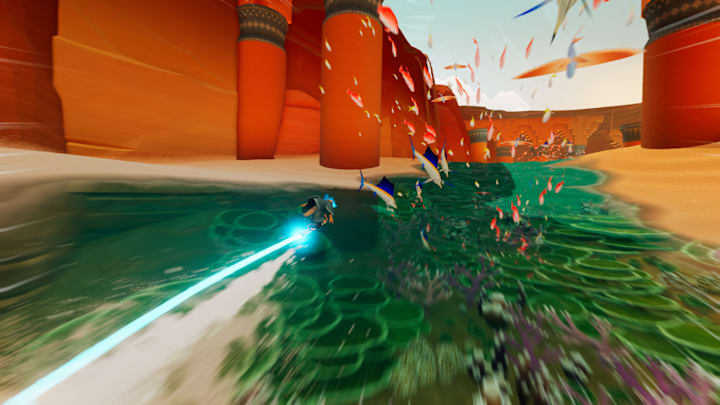Sword of the Sea review: Relax and ride the waves
By Ryan Woodrow

Every now and then, it’s nice to have a game that just washes over you for a few hours. I like a challenging boss or a head-scratching puzzle as much as the next guy, but sometimes I’d rather just not bother with all of that fuss and have some simple fun gliding about a beautiful world, an experience that Sword of the Sea is all too happy to provide.
You awaken as an ancient guardian in a world that is very sandy, and put simply, your goal is to make it not so sandy. You’ll be using your sword like a surfboard to ride the dunes with a movement system that is dead-simple but extremely satisfying, with how easily you glide over the terrain, only occasionally breaking to do a light bit of puzzle-platforming.
To open the paths before you, you’ll need to reach switches, avoid obstacles, bound over large gaps, and the like, and you have a very simple moveset to do so. You use the basic movement to build up momentum, then you can charge your jump to different intensities, before double-jumping in mid-air to carry that momentum and get more distance, and if you need just a little extra push, you can perform tricks to gently stall your descent and eke out just a little extra distance.
This trick system does get some fun uses too, as along the way you’ll find some skatepark-style areas where you’ll need to get air, wall ride, and perform tricks to build up your combo to beat a high score in a set amount of time. These are entirely optional distractions, but they do showcase that the movement system is more in-depth than it may first appear.
Your reward for doing all of this – for reaching each little objective – is that you get to watch this barren, desert land transform into a vibrant and beautiful ocean. The harsh bright browns are replaced with glowing blues and greens, with a great variety of colourful sea life gliding through both the water and the air, dancing like stars in the night sky.
After you’ve been staring at sand for so long, the transformation is an incredible sight to behold, but the game makes sure you get to feel it as well as see it with a very simple trick: you go faster when on water. That’s all it takes for you to feel rewarded for going through the effort of restoring life to the area; you get to experience this temporary rush of extra speed and momentum that takes you to the next area, where you’ll need to do it all over again.
And that’s the game. You do that on repeat for about three hours, occasionally unlocking a new little bit of movement tech to keep things interesting, as well as going through your classic run of desert world, ice world, lava world, to make sure the stunning visuals never get too mundane.
There is also a story, though it takes the less-is-more approach. You can find nodes around that will give you the lore and history of the world, but in terms of what’s on the main path, it’s a simple tale of two strangers coming together in a strange world to combat a force seemingly greater than them. The cutscenes are all pretty short and sweet, and even without any real combat, it still managed to climax satisfyingly in a “final boss” of sorts, so I can’t complain.
The puzzles aren’t particularly challenging, but that relaxing, easy-going vibe is exactly what the game is after, and it’s not like it doesn’t know how to tug on your gamer brain either. There’s a simple currency you can collect by finding chests throughout the world. You can then spend it to unlock new tricks and extra little bits of movement. They don’t fundamentally change the experience, but they are a nice little distraction that tugs you off the beaten path every now and then. They keep your brain engaged just enough that you never get bored.
Plus, once you beat the game for the first time, it lays out a challenge. After the credits roll, you’ll get a stats screen telling you how long you took to beat the game, combined with your total trick score across the game to give you a final high score. Since my initial, leisurely run through the game only took just under three hours, I immediately felt that temptation to drop back in and try to blitz through it for a better score.
I like that the game waits until after your first playthrough to present this idea to you. It knows exactly how it wants you to experience what it has to offer the first time around – you’re supposed to lose yourself in the world. Then, once you’ve had that experience, it’s more than happy to give you things like an on-screen speedometer and score-counter if you want to go around again with a more gamified focus.
Like Abzu before it, Sword of the Sea is a simple game that is worth anyone’s time, especially as it won’t take up much of it. It’s the kind of calming title that you can slip into a single evening and just let yourself be carried along by its satisfying movement, gorgeous visuals, and easy-going challenges.
Sword of the Sea. 8. PC. . Sword of the Sea
More reviews on DBLTAP:
feed